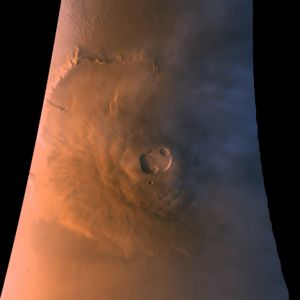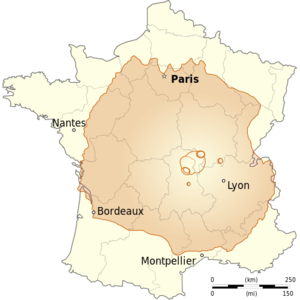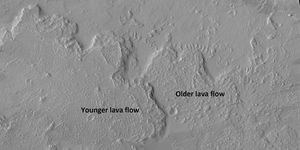Difference between revisions of "Olympus Mons"
(→References: added images) |
(→Pictures: added image) |
||
| Line 45: | Line 45: | ||
==Pictures== | ==Pictures== | ||
<Gallery> | <Gallery> | ||
| + | |||
| + | File:ESP 056023 1965lavaolympus.jpg|Lava flows on Olympus Mons. | ||
File:68460 1945laveolympus.jpg|Lava flowing down a slope from [[Olympus Mons]] | File:68460 1945laveolympus.jpg|Lava flowing down a slope from [[Olympus Mons]] | ||
| Line 51: | Line 53: | ||
</gallery> | </gallery> | ||
| − | |||
| − | |||
== References == | == References == | ||
Revision as of 08:06, 15 May 2021

Olympus Mons is a dormant shield volcano in the Tharsis region of Mars. It is easily the tallest volcano on Mars, and is believed to be the tallest in the Solar System.
Contents
Location
The volcano is located in Mars's western hemisphere at approximately 18.65 N and 226.2 E, just to the northwestern edge of the Tharsis Bulge. The western portion of the volcano lies in the Amazonis quadrangle and the central and eastern portions in the Tharsis quadrangle.
Dimensions
The top of Olympus Mons is the highest point on Mars. By one measure, it has a height of nearly 22 km (13.6 mi or 72,000 ft).[1]. Olympus Mons stands about two and a half times as tall as Mount Everest's height above sea level, and is currently the largest volcano discovered in the Solar System.
At 600 km (370 mi) in diameter the footprint of Olympus Mons covers an area of land comparable to the size of France.
Age
It is the youngest of the large volcanoes on Mars and some of the evidence from the ancient lava flows suggest a range in age from 115 million years old to 2000 million years old. This is relatively recent in comparison to most of Mars' other geology.
Composition
Rock
Much of the terrain is obscured by fine dust covering the underlying bedrock but Olympus Mons probably has the same composition to most of the dark areas on Mars which were formed by volcanic eruptions. The surface of Mars, including Olympus Mons is basalt of a type (tholeiites) similar to that of Earth's oceanic crust. This is the general conclusion drawn from Martian meteorites, analyses of soils and rocks at robotic landing sites, and information gathered with orbiting spacecraft.[2] [3]
Lava flows consisting of this composition would have low viscosity producing a watery flow that creates a typical shield volcanoes. Olympus Mons has a very gradual slope of, on average, only 5°.[4] It would be a long but very gentle climb up Olympus Mons.
High-altitude clouds frequently drift over the Olympus Mons summit, and airborne Martian dust is still present.[5] The typical atmospheric pressure at the top of Olympus Mons is about 12% of the average Martian surface pressure.[6]
Ice
As with tall mountains on the Earth, there has been much snowfall on Olympus Mons. Scientists see much evidence for glaciers.[7]
Exploration
Olmypus Mons has been known to astronomers since the late 19th century as the albedo feature Nix Olympica (Latin for "Olympic Snow"). Its mountainous nature was suspected well before space probes confirmed its identity as a mountain.[8]
Unfortunately Olympus Mons is an unlikely landing location for automated space probes in the near future. The high elevations preclude parachute-assisted landings because the atmosphere above is not sufficient to slow the spacecraft down before landing. Moreover, Olympus Mons stands in one of the dustiest regions of Mars. This would likely make rock samples hard to come by and the dust layer would also likely cause severe maneuvering problems for rovers.[9]
Pictures
Lava flowing down a slope from Olympus Mons
References
- ↑ Plescia | first1 = J. B. | year = 2004 | title = Morphometric Properties of Martian Volcanoes | url = | journal = J. Geophys. Res. | volume = 109 | issue = | page = E03003
- ↑ McSween Jr., H. Y., Taylor, G. J., and Wyatt, M. B. 2009. Elemental Composition of the Martian Crust. Science, v. 324(5928), p.736-739, doi: 10.1126/science.1165871.
- ↑ "Mars Crust : Made of Basalt" http://www.psrd.hawaii.edu/May09/Mars.Basaltic.Crust.html
- ↑ Wikipedia Olympus Mons https://en.wikipedia.org/w/index.php?title=Olympus_Mons
- ↑ Hartmann, W.K. A Traveler’s Guide to Mars: The Mysterious Landscapes of the Red Planet. Workman: New York, 2003, p. 300.
- ↑ Public Access to Standard Temperature-Pressure Profiles
- ↑ Basilevsky, A. (2006). "Geological recent tectonic, volcanic and fluvial activity on the eastern flank of the Olympus Mons volcano, Mars". Geophysical Research Letters 33 (13): 13201, L13201. doi:.
- ↑ Patrick Moore. 1977. Guide to Mars. London (UK). Cutterworth Press, p. 96
- ↑ https://en.wikipedia.org/w/index.php?title=Olympus_Mons











